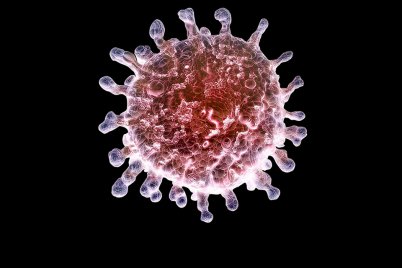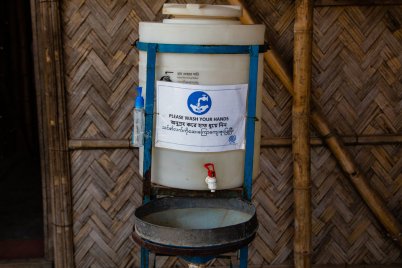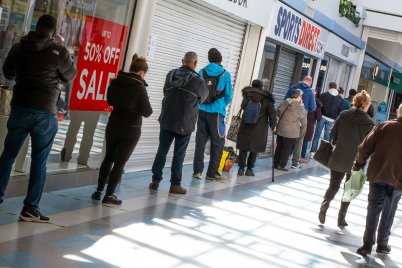
This feature is available for republication under a Creative Commons licence.
On the last day of 2019, authorities in China informed the World Health Organization of an unusual pneumonia that was circulating in the city of Wuhan, in Hubei province.
This novel disease was quickly identified as a coronavirus – one of several such viruses circulating in animals, of which only six had ever made the jump into humans.
Just over four months later the virus – now called COVID-19 – has spread to nearly every country in the world, overwhelmed even the most sophisticated health systems, and led to huge changes in the daily lives of billions of ordinary citizens.
The new disease has also prompted a massive international research response with scientists from the London School of Hygiene & Tropical Medicine at the forefront
And one team particularly in demand is at the Centre for Mathematical Modelling of Infectious Diseases (CMMID). Currently led by Professor Graham Medley, who specialises in modelling infectious diseases to reduce death and disability, CMMID’s work in predicting the spread of the disease has been crucial to informing government policy both in the UK and around the world.
Infectious disease modelling has a long history in the UK. It was used to great effect during the 2009 H1N1 (swine flu) pandemic and the 2013-16 Ebola outbreak in West Africa. As well as playing a crucial role during global health emergencies, it also supports ‘year to year’ public health decision-making, such as planning routine vaccination programmes
“The UK really is a global leader in mathematical modelling and it’s not just in science but the way science is used in policy,” says John Edmunds, professor of infectious disease modelling at LSHTM and a member of a number of the UK’s key advisory bodies, such as the Scientific Advisory Group for Emergencies (SAGE) and the New and Emerging Respiratory Threats Advisory Group (NERVTAG).
He says government decision-makers are aware of both the limitations of modelling and how to use it. For example, the UK decided against screening travellers arriving in UK airports after work, including by CMMID, showed that thermal temperature checks would pick up less than one in five of all infected passengers coming from China, and even fewer for passengers arriving from closer to home, such as Italy.
Sir Patrick Vallance, the UK government’s chief scientific adviser, has commended the contribution of academics at the LSHTM in aiding understanding of the pandemic. In a letter to Professor Peter Piot, director of LSHTM, he urged academics to continue their crucial work:
“[The experts’] ongoing input is vital to our response and we are grateful for the significant contribution they have already made.”
Sir Patrick Vallance
What is infectious disease modelling?
In an outbreak of a new disease such as COVID-19, the first thing scientists seek to understand is how transmissible the disease is and how quickly it might spread.
Infectious disease models combine data with assumptions about what might happen – as more information emerges about the disease, the model results are more driven by data than assumptions.
Modellers take evidence from a variety of sources, says Dr Rosalind Eggo, an assistant professor in the Department of Infectious Disease Epidemiology. They consider what happens when someone becomes infectious, when they start showing symptoms and how these factors tie together.
“Then we bring in demographic and social data, how many contacts people have and how that varies with the demography of a population,” she says.
Age has been a focus for Dr Eggo in this outbreak as at the beginning the role of children in spreading COVID-19 was unclear.
Early data from China showed that few children were infected – was this because they had not been exposed to the disease as the pandemic first emerged during school holidays? Or was it because children were either not susceptible or picked up COVID-19 but showed few symptoms?
Understanding children’s role in driving transmission in a pandemic is vital, says Dr Eggo, as school closures are often key interventions in control.
“As more evidence emerged, it appeared that children may not have as large a role in driving transmission as we thought, and mostly do not show severe symptoms on infection,” she says.
Another area Dr Eggo studied early in the pandemic was the impact of the long-standing public health intervention of contact tracing. She used a scenario-based model to work out its effectiveness.
“This was in January when there was a lot more uncertainty. At that point people had pretty good evidence that the time from getting infection to showing symptoms was about five days. It was clear then and clear now. But what was much more uncertain was how much transmission happened before people show symptoms.
“In the models of contact tracing and isolation we looked at what happens if there’s no transmission before symptoms, if there’s a little bit—15 per cent—and quite a bit like 30 per cent.
“This is scenario-based modelling – you take uncertainties and how much effect interventions would have,” says Dr Eggo.
That piece of work, published in the Lancet Global Health, concluded that 60 to 80 per cent of contacts would have to be traced and transmission stopped to achieve control of the disease. It also found that the more infection there was before symptoms showed the less likely it was that the disease could be controlled.
Other important pieces of early modelling looked at fatality rates – researchers used data from the Diamond Princess cruise ship, where passengers were quarantined for nearly a month, and compared it with early data from China.
“It enabled us to spot the biases in the China data and make adjustments,” says Dr Adam Kucharski, associate professor in the Department of Infectious Disease Epidemiology.
At the beginning of the outbreak there was a lot of uncertainty around the numbers, but modellers make assumptions and use evidence from other disease outbreaks to test scenarios.
“We feed in bits of evidence to a model of transmission where there is a synthetic population and then simulate interactions between different groups. We then look at different interventions: if we close schools, if we shield these different groups, if we have people self isolating – how do all those things reduce transmission in the model?” says Dr Kucharski.
Dr Adam Kucharski talks us through mathematical modelling and how the CMMID team are responding to COVID-19, in this LSHTM Viral episode from 13 Feb 2020:
Models are not perfect and they cannot tell you everything but even early on in the outbreak Prof Edmunds was certain that the disease would spread around the world. He made his prediction on the institution's inaugural coronavirus podcast — LSHTM Viral — on January 30, the day before the first case in the UK.
Testing lockdown
One piece of work undertaken by CMMID formed a crucial part of the scientific evidence showing what path the epidemic might take in the UK – and what might be require to control it.
Researchers were tasked by the government to look at the impact of various “social distancing” interventions in controlling the outbreak, work that has since been summarised in a preprint paper.
Initially the researchers looked at the worst-case scenario of what would happen if there were no control measures and the disease was allowed to run its course. This showed there could be around 24 million clinical cases of the disease in the UK by December 2021 and around 85 per cent of the population would be infected. There could also be around 370,000 deaths.
This was a dynamic piece of work, with the government asking researchers to look at a range of measures such as shutting down sporting events and closing non-essential shops, pubs and restaurants.
They were also asked to consider the impact of school closures on transmission of the virus to grandparents as they might be asked to provide child care.
The group simulated individual interventions such as school closures, shielding of vulnerable populations and the extreme lockdown – looking at each intervention individually and in combination with others.
Researchers also projected new cases over time, the number of patients requiring hospitalisation and intensive care capacity as well as fatality rates.
The paper concluded that to keep intensive care bed demand below capacity, extreme restrictions were needed. This would delay the peak of the epidemic by about eight weeks and cut the number of deaths – however, even in this scenario, existing intensive care bed capacity could still be stretched.
Members of the team are also working to understand the most effective responses to COVID-19 in low and middle-income countries. Alongside humanitarian researchers at LSHTM, they have recently published work that suggested, instead of the European-style lockdowns, that self-isolation alongside moderate physical distancing and shielding would be a more reasonable strategy for African countries.
Lifting lockdown
Now the modellers are looking at the opposite scenario – how to get out of lockdown.
Dr Kucharski says that interventions introduced early on in the UK epidemic are likely to be lifted last.
“To some extent lifting the lockdown will be the inverse of what we did to reduce transmission.
“For example, asking people to self-isolate if they’re ill is not very disruptive to the wider population so it’s unlikely it will be the first to be lifted. It would be frustrating as a measure, but you could have it in place for years,” he says.
Some types of non-essential shops may be allowed to re-open and people may be permitted to socialise with friends and family as long as physical distancing measures are observed.
“At the more extreme end of the scale, if you allowed everyone to go back to work you would expect to see a pretty dramatic increase in the number of cases,” says Dr Kucharski.
To stop the disease spreading, transmission has to be reduced by 50 to 70 per cent – lockdown is probably already achieving that - but the country cannot stay shut at home forever not least because of the social and economic impacts.
“We will have to ease some of these restrictions – if you ease them too much the epidemic will come back. It will be quite a fine judgement,” says Prof Edmunds.
Such sentiments were echoed by England’s Chief Medical Officer Chris Whitty, former professor of Public and International Health at LSHTM, on 22 April, when asked about vaccines and treatments:
“Until we have those, and the probability of having those anytime in the next calendar year are incredibly small – I think we should realistic about that – we are going to have to rely on other social measures.”
There are additional, less disruptive, ways to reduce transmission, such as introducing more aggressive contact tracing. But even Singapore, whose track record in such public health interventions is legendary – every suspected case is tested; anyone who comes into contact with a confirmed case is tracked and confined to their homes until they are cleared – has had to introduce more rigorous controls as the number of cases has started to rise again.
There has also been discussion of so-called immunity passports, where people who test positive for antibodies against the disease will be allowed to move about more freely.
Dr Kucharski is sceptical about the value of such tests, however.
“Say antibody tests are about 95 per cent accurate. At a population level you can get a rough sense of where you are. But when infection is at low levels, the individual results will be less conclusive. Issuing an immunity passports to someone would be the equivalent of passport office issuing a passport if they’re only maybe 80 per cent sure it’s you,” he says.
Tracking behaviour
One innovation pioneered by LSHTM researchers in this pandemic has been assessing the impact of the massive changes in people’s behaviour lockdown has brought about.
This is the first time during an outbreak that LSHTM’s modellers have been able to use what they describe as ‘behavioural surveillance’ and it is providing rapid insights, says Prof Edmunds.
During the Ebola outbreak in West Africa, behaviour change was a key way of controlling the epidemic. Hand washing, social distancing and the introduction of safe burials, where people abandoned the traditional practice of washing the body of their loved ones, all helped slow down the spread of the disease for which, at the time, there was no vaccine or treatment.
However, whilst these changes undoubtedly helped to bring the epidemic to an end, their impact was not measured.
But now LSHTM researchers are conducting a survey of individuals to work out how their behaviour has changed. In the first wave 1,300 people were asked to list their contacts the day before lockdown was implemented. The results were compared with a similar survey carried out in 2005 to 2006, which give a measure of baseline contact patterns.
The survey found that the number of contacts fell by 70 per cent and researchers worked out it would lead to the disease’s reproduction number falling below one.
This all-important figure is the number of people who catch the disease from an infected person – to stop the spread of the disease the reproduction number has to fall to below one.
This behavioural survey is an important early way of gauging the success of the control measures long before the number of cases and deaths begins to fall, says Prof Edmunds.
“Behaviour change today won’t have an impact on cases and hospitalisations for some weeks but the survey shows that the lockdown has been effective. It’s much quicker than looking at epidemiological data,” he says.
Rapid science
The publication of these findings is one example of the huge research effort that has characterised the pandemic. Papers are being published on an unprecedented scale and at a dizzying pace, with traditional scientific journals with their long publication times being bypassed and research going out on pre-print servers such as medRxiv.
CMMID has its own version of a pre-print server and has introduced an internal peer-review system where academics not involved in the paper give feedback on each study before it goes online.
During a fast-moving outbreak of a novel disease it is important that research is published quickly.
There was a lot of frustration that very little research came out of the West Africa Ebola outbreak, says Dr Kucharski.
“People did sit on data – it was not people being malicious, it was just scientific culture not being designed for this sort of outbreak. I think people did learn a lot of lessons and we saw sequence data coming out really quickly this time.
“There’s been a big push to open research. It will be interesting to see how the journal system holds up after these changes,” he says.
Dr Eggo says the whole research community is pulling together – not just disease modellers but everyone from vaccine experts, transport specialists, to behavioural scientists are pitching in.
“This is having an impact on every sphere. It’s heartening to see every kind of science trying to help,” she says.
There is no doubt that collaboration at a regional, national, and global level is absolutely key to stopping this pandemic. With other scientists in the UK and around the world, LSHTM's modellers will continue to help unlock the secrets of COVID-19.
Live Q&A
On 1 May, LSHTM experts Professor John Edmunds OBE and Dr Petra Klepac answered questions from the public on infectious disease modelling for COVID-19 in a live broadcast Q&A. Watch the recording.
COVID-19 Response Fund
There cannot be any complacency as to the need for global action.
With your help, we can plug critical gaps in the understanding of COVID-19. This will support global response efforts and help to save lives around the world.





